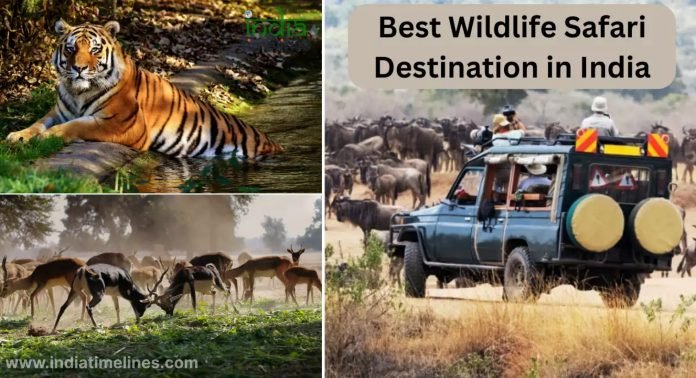
Embarking on a wildlife safari is an exhilarating adventure that allows you to connect with nature’s wonders. As the demand for unique travel experiences grows, India emerges as a top destination for wildlife enthusiasts. India Awaits will explore the best wildlife safari destinations in India, providing insights into the rich biodiversity, unique experiences, and practical tips for an unforgettable journey.
India’s Rich Biodiversity
India boasts a diverse range of ecosystems, from lush rainforests to arid deserts, fostering a remarkable array of flora and fauna. The country’s national parks and wildlife sanctuaries are home to iconic species like Bengal tigers, Indian elephants, and one-horned rhinoceroses.
Top Wildlife Safari Destinations in India
Jim Corbett National Park

Jim Corbett National Park is a renowned wildlife sanctuary located in the Indian state of Uttarakhand. It is famous for its diverse flora and fauna, as well as being a habitat for the Bengal tiger. Here are some details about the park, the best times to visit, and activities you can enjoy:
Jim Corbett National Park:
- Location:
- Jim Corbett National Park is situated in the Nainital district of Uttarakhand, India.
- It covers an area of about 520 square kilometers.
- Wildlife:
- The park is home to a variety of wildlife, including elephants, deer, leopards, and over 600 species of birds.
- The Bengal tiger is a major attraction, and Corbett is one of the best places in India to spot this majestic big cat.
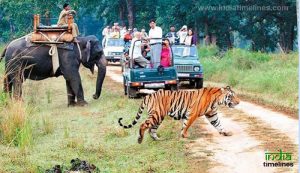
Bengal tiger Wildlife Safari in India
- Best Time to Visit:
- Winter (November to February): The weather is pleasant, and wildlife is easier to spot as the foliage is less dense.
- Summer (March to June): Ideal for bird watching, and chances of spotting animals near water sources are higher.
- Monsoon (July to September): The park is closed during this period due to heavy rainfall.
- Safari Options:
- Jeep Safaris: Explore the park in an open jeep, accompanied by a trained guide.
- Elephant Safaris: A unique experience to spot wildlife from the back of an elephant.
- Corbett Museum:
- Located at Kaladhungi, it was the home of Jim Corbett, the famous hunter, naturalist, and author.
- Dhikala Zone:
- Known for its diverse topography, it offers the best chances of spotting tigers.
- Garjia Temple:
- Situated on the banks of the Kosi River, it’s a popular religious spot amid scenic surroundings.
- Adventure Activities:
- River Rafting in the Kosi River.
- Nature Walks and Bird Watching.
- Corbett Waterfall:
- A beautiful waterfall surrounded by lush greenery, ideal for a refreshing break.
- Photography:
- The park’s diverse landscapes provide excellent opportunities for photography enthusiasts.
- Accommodation:
- There are various resorts and forest rest houses within and around the park for accommodation.
- Conservation Programs:
- Some lodges and resorts conduct awareness programs about wildlife conservation.
Tips for Visitors:
Permits:
Entry into the park is allowed only with the necessary permits, which can be obtained online or from the park’s entry gates.
Guides:
It is advisable to take a trained guide along during safaris for a better understanding of the flora and fauna.
Clothing:
Dress comfortably and wear colors that blend with the surroundings to avoid disturbing the wildlife.
Time Required: Plan for approximately 5 hours for a safari adventure in Jim Corbett.
Jim Corbett Safari Costs:
Jeep safari rates – INR 4500 (for Indians); INR 7500 (for Foreigners)
Canter safari fees – INR 1200 (for Indians); INR 3000 (for Foreigners)
Elephant safari fees – INR 3500 (applicable for both Indians and Foreigners)
Jim Corbett National Park offers a unique and enriching experience for nature and wildlife enthusiasts. Whether you are interested in bird watching, tiger spotting, or simply enjoying the serenity of the natural surroundings, the park has something for everyone.
Ranthambore National Park
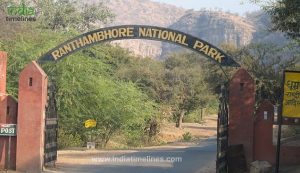
Ranthambore National Park is a renowned wildlife sanctuary located in the Sawai Madhopur district of Rajasthan, India. It is particularly famous for its population of Bengal tigers and offers a unique blend of natural beauty and historical landmarks. Here are some of the best places to visit and fun activities to engage in at Ranthambore National Park:
- Ranthambore Fort:
- Explore the historic Ranthambore Fort, which is situated within the national park. The fort dates back to the 10th century and provides panoramic views of the surrounding area.
- Trinetra Ganesh Temple:
- Visit the Trinetra Ganesh Temple located inside the Ranthambore Fort. It is dedicated to Lord Ganesha and is a significant pilgrimage site.
- Wildlife Safari:
- Take a wildlife safari to witness the diverse flora and fauna of Ranthambore. Safaris are conducted both in the morning and evening, providing opportunities to spot tigers, leopards, sloth bears, and a variety of bird species.

Wildlife Safari Ranthambore National Park
- Take a wildlife safari to witness the diverse flora and fauna of Ranthambore. Safaris are conducted both in the morning and evening, providing opportunities to spot tigers, leopards, sloth bears, and a variety of bird species.
- Padam Talao:
- Enjoy the scenic beauty of Padam Talao, the largest of the Ranthambore Park’s lakes. It’s an excellent spot for birdwatching and observing wildlife.
- Malik Talao:
- Another picturesque lake in the park, Malik Talao is known for its population of crocodiles and is a great place for bird enthusiasts.
- Raj Bagh Ruins:
- Explore the ancient ruins of Raj Bagh, located between Padam Talao and Raj Bagh Talao. These ruins add a historical charm to the wildlife experience.
- Kachida Valley:
- Opt for a safari to Kachida Valley, which is less frequented by tourists. It offers a tranquil setting and a chance to spot wildlife away from the more crowded zones.
- Surwal Lake:
- If you have time, visit Surwal Lake, located near the park. It’s a serene spot with a variety of birdlife.
Best Time to Visit:
- The best time to visit Ranthambore National Park is from October to March when the weather is pleasant, and wildlife is relatively easy to spot. The park is closed during the monsoon season (July to September).
Fun Activities:
- Engage in photography, capturing the diverse wildlife and scenic landscapes.
- Attend nature walks and bird watching sessions organized by the park authorities.
- Participate in cultural programs and events organized by local communities.
Time Required: 3.5 hours
Ranthambore Jungle Safari Prices:
Ranthambore Jeep Safari: INR 1500 per person (Indian), INR 2900 per person (Foreigners)
Ranthambore Canter Safari: INR 1200 per person (Indian), INR 2300 per person (Foreigners)
Special Safaris:
Half-day Safari: INR 46,000 (Indian), INR 56,000 (Foreigners)
Full-day Safari: INR 57,000 (Indian), INR 72,000 (Foreigners)
Remember to check for the latest updates on park regulations and wildlife sightings before planning your visit. Enjoy your time at Ranthambore National Park!
Sundarbans National Park

The Sundarbans National Park is a UNESCO World Heritage Site located in the delta region of Padma, Meghna, and Brahmaputra river basins. It is renowned for its diverse flora and fauna, including the Bengal tiger. Here are some best places to visit and fun activities to enjoy in the Sundarbans:
- Sundarbans Tiger Reserve:
- The Sundarbans is home to the Bengal tiger, and the Tiger Reserve is a key area for spotting these majestic creatures. Take a boat safari along the waterways to increase your chances of spotting tigers and other wildlife.
- Sajnekhali Wildlife Sanctuary:
- This sanctuary is a popular spot for birdwatching. It houses an interpretation center, a watchtower, and a museum, providing valuable information about the flora and fauna of the region.
- Dobanki Watchtower:
- Dobanki offers a spectacular view of the Sundarbans. It is an ideal place for birdwatching and observing wildlife. The canopy walk at Dobanki is a unique experience, allowing you to explore the forest from an elevated walkway.
- Netidhopani:
- Known for its ancient temple, Netidhopani is believed to be a place of worship for both Hindus and Buddhists. The area is also known for its archaeological significance.
- Halliday Island:
- Enjoy a serene boat ride to Halliday Island, where you can relax and take in the natural beauty. The island is named after Sir Frederic John Halliday, a former lieutenant governor of Bengal.
- Tin Kona Island:
- Famous for its three-cornered shape, Tin Kona Island is a picturesque location. The island is home to various species of birds, and it’s an excellent spot for bird enthusiasts.
Best Time to Visit:
The best time to visit the Sundarbans is during the winter months, from November to February, when the weather is pleasant and wildlife is more active. Avoid the monsoon season (June to September) due to heavy rainfall and the summer months (March to June) when temperatures can be uncomfortably high.
Fun Activities:
-
- Boat Safaris: Explore the intricate network of waterways and mangrove forests on a boat safari.
- Birdwatching: The Sundarbans is a haven for birdwatchers with its diverse avian population.
- Photography: Capture the stunning landscapes, wildlife, and unique flora of the Sundarbans.
- Cultural Exploration: Learn about the local culture and traditions by interacting with the communities living in the Sundarbans.
Time Required: 4 hours and 8 hours
Sundarbans ecotourism charges: INR 2600 per person
Remember to check the latest travel advisories and regulations before planning your visit to ensure a safe and enjoyable experience in the Sundarbans National Park.
Kaziranga National Park
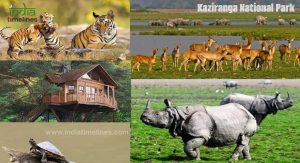
Kaziranga National Park, located in the northeastern state of Assam, India, is renowned for its incredible biodiversity, particularly its population of the Indian one-horned rhinoceros. Here are some of the best places to visit and activities to enjoy in Kaziranga:
- Kohora Range:
- This range is the central zone of Kaziranga and offers various accommodations for tourists. You can find hotels, resorts, and even government lodges here.
- Bagori Range:
- Situated in the western part of the park, Bagori is known for its picturesque landscapes. The Bagori Range has a tourist interpretation center and is an excellent place for bird watching.
- Agaratoli Range:
- Located in the eastern part of Kaziranga, Agaratoli is known for its beautiful scenery and is an ideal spot for bird enthusiasts. The range is also home to a diversity of wildlife.
- Burmese Temple:
- Situated near the Range Office in Kaziranga, the Burmese Temple is an interesting place to visit. It’s a serene spot with a unique architectural style.
- Kaziranga Orchid and Biodiversity Park:
- This park is dedicated to showcasing the rich biodiversity of the region. It’s a great place to learn more about the flora of Kaziranga.
- Elephant Safari:
- Explore the park on elephant-back for a unique and close-up view of the wildlife. Elephant safaris are an exciting way to spot rhinos, tigers, and other animals.
- Jeep Safari:
- Jeep safaris are a popular choice for wildlife enthusiasts. The park is divided into different zones, and each offers a unique experience. The morning and afternoon safaris are the best times for animal sightings.
- Bird Watching:
- Kaziranga is a haven for birdwatchers. The park is home to a wide variety of resident and migratory birds. Bring your binoculars and enjoy spotting different bird species.
- River Safari on the Brahmaputra:
- Take a river safari on the Brahmaputra River to explore the park from a different perspective. It’s an excellent opportunity to see river dolphins and enjoy the scenic beauty.
- Visiting the Tea Gardens:
- Assam is famous for its tea, and you can visit the nearby tea gardens to witness the tea-making process and enjoy the lush green landscapes.
Best Time to Visit: The best time to visit Kaziranga National Park is from November to April. During this period, the weather is pleasant, and the park is open for tourists. The winter months of December to February are particularly good for wildlife sightings, as the grass is shorter, making it easier to spot animals.
Keep in mind that the park is closed during the monsoon season (June to October) due to heavy rains and flooding. It’s advisable to check the park’s official website or contact the authorities for the latest information on opening times and safari availability.
Time Required: 2 Hours
Safari charges at Kaziranga National Park: INR 3800-4500 per jeep
Periyar National Park
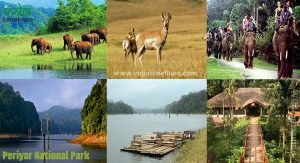
Periyar National Park is a renowned wildlife sanctuary located in the Western Ghats of Kerala, India. It is known for its rich biodiversity, scenic beauty, and opportunities for wildlife spotting. Here are some of the best places to visit and activities to engage in when you are at Periyar National Park:
- Periyar Lake: The heart of the national park, Periyar Lake is a picturesque water body where you can enjoy a boat ride. The boat ride offers a unique opportunity to spot wildlife such as elephants, deer, and various species of birds along the shores.
- Mullaperiyar Dam: This is a popular attraction near the park. The dam is surrounded by lush greenery and offers breathtaking views. It’s a great spot for photography and enjoying the serene atmosphere.
- Periyar Tiger Reserve: The core area of the park is the Periyar Tiger Reserve, where you have a chance to spot the elusive Bengal tiger. Guided safaris are available for visitors to explore the reserve and witness the diverse wildlife.
- Bamboo Rafting: For adventure enthusiasts, bamboo rafting is a unique experience offered in Periyar. It involves a full-day trek and rafting expedition, allowing you to explore the deeper parts of the forest.
- Elephant Junction: Located near Thekkady, Elephant Junction offers various activities like elephant rides, interaction sessions, and bathing sessions with elephants. It’s an enjoyable experience for animal lovers.
- Chellarkovil Viewpoint: For panoramic views of the surrounding landscapes, visit Chellarkovil Viewpoint. It’s a short drive from Thekkady and provides breathtaking vistas of plains and hills.
- Border Hiking: Organized by the forest department, border hiking is a full-day trekking program along the borders of the Periyar Tiger Reserve. It’s a great way to explore the diverse flora and fauna of the region.
Best Time to Visit: The best time to visit Periyar National Park is during the winter months from October to February when the weather is pleasant. The wildlife is more active during this time, and the chances of spotting animals are higher.
In conclusion, Periyar National Park offers a perfect blend of wildlife, adventure, and natural beauty. Whether you’re interested in boat rides, wildlife safaris, or trekking, Periyar has something for every nature lover.
Time Required: 4-5 hours
Periyar Wildlife Sanctuary safari charges: Jeep safari – INR 2000 per person
Unique Experiences in Each Destination
Each wildlife destination in India offers distinct experiences. In Jim Corbett, the thrill of tracking tigers in diverse landscapes awaits, while Ranthambore combines wildlife sightings with a glimpse into India’s regal past. Sundarbans’ mangrove ecosystem presents a different adventure, and Kaziranga’s rhino encounters are unmatched. Periyar’s blend of boat safaris and wildlife sightings provides a multifaceted experience.
Choosing the Right Safari Package
Selecting the right safari package is crucial for a seamless experience. Factors like accommodation, guided tours, and transportation play a pivotal role. Fortunately, there are budget-friendly options available, allowing wildlife enthusiasts with various budgets to enjoy the beauty of India’s national parks.
Wildlife Conservation Efforts in India
Beyond the thrill of a safari, it’s essential to understand and support wildlife conservation efforts. India has implemented various initiatives to protect endangered species and their habitats. Responsible tourism plays a vital role in sustaining these efforts, ensuring future generations can also marvel at the country’s incredible biodiversity.
Photography Tips for Wildlife Safaris
Capturing the essence of a wildlife safari requires the right equipment and techniques. From choosing the ideal camera lens to mastering the art of wildlife photography, this section provides valuable tips for enthusiasts eager to document their safari experiences.
Local Culture and Cuisine
Exploring the areas surrounding wildlife destinations unveils not just natural wonders but also vibrant local cultures. Engage in cultural experiences and savor local dishes to enhance your overall journey. From traditional dances to flavorful cuisines, there’s more to discover beyond the safari trails.
Accommodation Options
Choose accommodations that align with your preferences, whether it’s luxury resorts or eco-friendly lodges. This section provides recommendations for a comfortable stay, ensuring you recharge for each day of exploration.
Safety Guidelines for Wildlife Safaris
While the thrill of encountering wildlife is unparalleled, it’s essential to prioritize safety. This section outlines crucial safety precautions and guidelines for responsible interaction with wildlife, ensuring a secure and enjoyable safari experience.
Testimonials from Safari Enthusiasts
Real-life experiences from fellow safari enthusiasts add a personal touch to your journey. Discover the awe-inspiring moments and unique encounters shared by those who have ventured into the heart of India’s wildlife sanctuaries.
Wildlife Safari Trends in India
The safari industry is evolving, incorporating technology and innovative practices. Stay informed about emerging trends that enhance the overall safari experience, from interactive apps to virtual reality tours.
Future of Wildlife Conservation and Tourism in India
As we look ahead, ongoing projects and future prospects shape the landscape of wildlife conservation and tourism in India. Learn about the collaborative efforts that aim to preserve the country’s natural treasures while promoting sustainable tourism.
India stands as a beacon for wildlife enthusiasts seeking an unparalleled safari experience. From the regal landscapes of Ranthambore to the serene waters of Periyar, each destination offers a unique blend of nature, culture, and adventure. Embrace the call of the wild, and let India’s national parks weave unforgettable stories of biodiversity and conservation.
FAQs
- Are wildlife safaris safe for families?
Yes, wildlife safaris are generally safe for families, with guidelines in place to ensure visitor safety. - What is the best time to visit Sundarbans National Park
The best time to visit Sundarbans is during the winter months, from November to February, for comfortable weather and optimal wildlife sightings - Can I book a budget-friendly wildlife safari package?
Absolutely, there are budget-friendly safari packages available, providing an affordable yet enriching experience. - Are there any restrictions on photography during safaris?
While photography is allowed, there are guidelines to ensure minimal disturbance to wildlife. Always follow park regulations. - How does wildlife tourism contribute to conservation?
Proceeds from wildlife tourism often fund conservation initiatives, contributing to the protection of endangered species and their habitats.


































